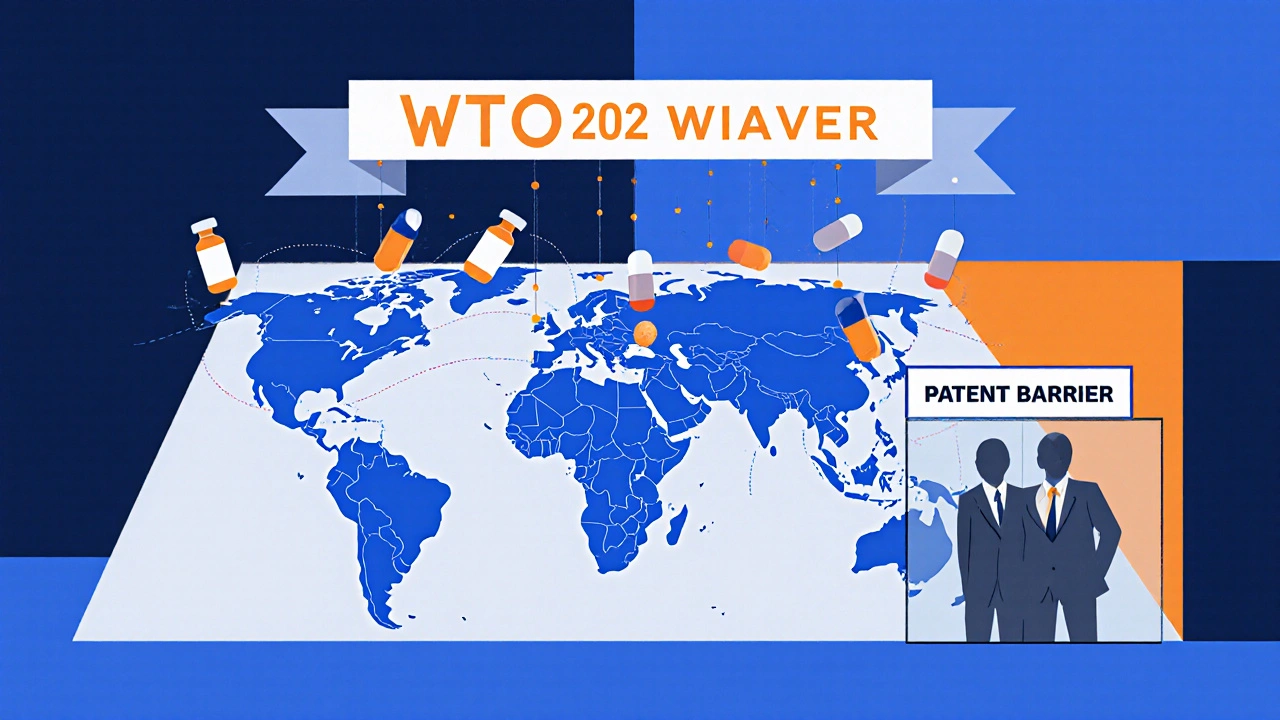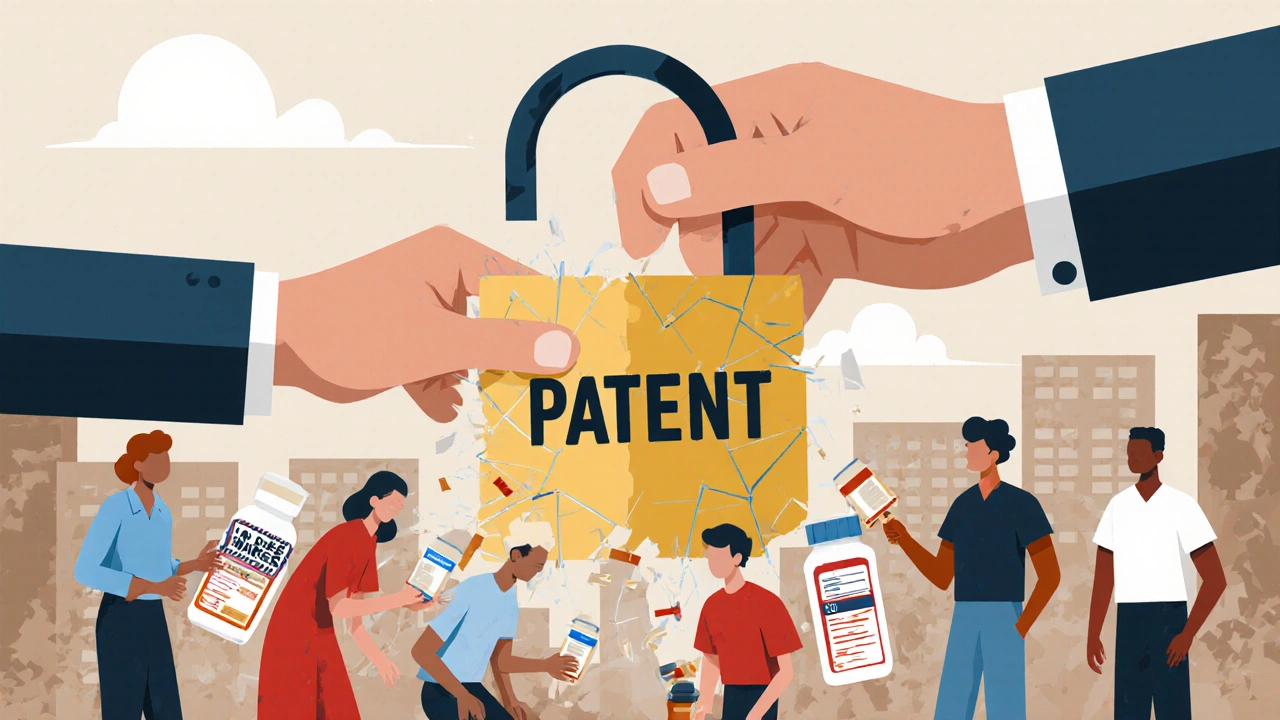When a life-saving drug costs more than a person’s yearly income, who gets to decide if it’s still fair? That’s where compulsory licensing comes in - a legal tool that lets governments step in and let others make or sell a patented product, even if the patent holder says no. It’s not about stealing ideas. It’s about making sure people can actually get medicine when they need it most.
What Exactly Is Compulsory Licensing?
Compulsory licensing is when a government gives permission to someone else - usually a generic drug maker - to produce a patented invention without the patent owner’s approval. The patent holder still gets paid, but they don’t get to block access. This isn’t a loophole. It’s written into international law.
The foundation for this came from the 1994 TRIPS Agreement under the World Trade Organization. Article 31 says countries can issue these licenses if there’s a public health emergency, a shortage of supply, or if the patent holder isn’t making the product available at a reasonable price. The key rule? The license must be mostly for the country’s own use. And the patent owner must get fair compensation - not a gift, not a punishment, but a price that reflects what the invention is worth.
Before 2001, many countries couldn’t even use this tool effectively because they didn’t have the manufacturing capacity to make the drugs themselves. Then came the Doha Declaration, which clarified that public health trumps patent rights in emergencies. That changed everything.
When Has It Been Used - And Why?
Compulsory licensing isn’t theoretical. It’s been used in real crises - and it’s saved lives.
In 2001, Brazil issued a compulsory license for efavirenz, an HIV drug made by Merck. The price dropped from $1.55 per tablet to just $0.48. That meant thousands more people could afford treatment. Thailand did something similar with lopinavir/ritonavir, slashing the annual cost from $1,200 to $230. In India, the first-ever compulsory license in 2012 was for Nexavar, a kidney and liver cancer drug. Bayer, the patent holder, was selling it for $5,500 a month. Natco Pharma started making a generic version for $175. The court said: if you’re not making it affordable, someone else should be able to.
During the COVID-19 pandemic, over 40 countries - including Canada, Germany, and Israel - prepared to use compulsory licensing for vaccines, tests, and treatments. Some, like Spain, passed emergency laws that skipped the usual requirement to first ask the patent holder nicely. Time was running out. Negotiations would have cost lives.
Even in the U.S., the tool exists - though it’s rarely used. Section 1498 of U.S. law lets the federal government use any patented invention without permission, as long as it pays compensation. That’s how the government got access to pandemic-related tech. The Bayh-Dole Act also lets agencies like the NIH force licensing of drugs developed with public funding - but they’ve never actually done it, even when drug prices spiked.
How Does It Work in Different Countries?
Not every country uses compulsory licensing the same way. Some have strong laws but never use them. Others use them often.
India leads the pack. Since 2005, it’s issued 22 compulsory licenses - almost all for cancer drugs. The process requires applicants to prove they tried to get a voluntary license first. But if there’s a public health emergency, that step can be skipped. The Intellectual Property Appellate Board handles these cases, and decisions take 18 to 24 months.
Germany has the legal right to issue compulsory licenses for public interest reasons, but it’s never done it. Why? Because drug companies usually lower prices before it gets to that point. The threat alone works.
Canada’s system changed in 2020. Now, if a drug is needed during a public health emergency, the government can issue a license without waiting for negotiations. They used it once - to send HIV drugs to Rwanda under a special WTO rule that lets countries without manufacturing capacity import generics made under compulsory license.
The European Union is moving toward faster procedures. In 2023, the Commission proposed that patent holders must respond to licensing requests within 30 days - or risk automatic compulsory licensing. That’s a big shift from the old model of waiting years for a court decision.
Who Benefits - And Who Loses?
The biggest winners are patients. In low- and middle-income countries, compulsory licensing helped cut the price of first-line HIV drugs by 92% between 2000 and 2020. Generic manufacturers like Teva saw billions in new revenue from these markets.
But it’s not without controversy. Pharmaceutical companies argue that if governments can override patents too easily, they’ll stop investing in new drugs. A 2018 study found that countries with active compulsory licensing programs saw 15-20% less R&D investment in pharmaceuticals. The IFPMA says each license announcement causes an average 8.2% drop in a company’s stock price.
But here’s the counterargument: the threat of compulsory licensing has pushed companies to lower prices voluntarily in 90% of HIV drug cases since 2000. In other words, it works as a bargaining chip. No one needs to actually issue a license if the company agrees to fair pricing.
And let’s be clear - most patents aren’t being used to help people. They’re being used to keep prices high. In 2022, only 12 countries had ever issued a compulsory license for pharmaceuticals, out of 164 WTO members. That means the tool is rarely used - but when it is, it changes everything.
The Legal Hurdles Are Real
Getting a compulsory license isn’t easy. It’s expensive, slow, and full of legal traps.
In the U.S., using Section 1498 means suing the government in the Court of Federal Claims. The average case takes 2.7 years. Compensation? Around $5.2 million per case. That’s a lot - but it’s not the same as stopping a drug from being sold.
India’s process is clearer but still takes years. The court must decide what “adequate remuneration” means. In the Nexavar case, they set it at 6% of net sales. That’s a formula - not a negotiation. It’s transparent. That’s why it worked.
But many countries - especially in Africa and Southeast Asia - don’t have the lawyers, judges, or technical staff to even start the process. The WHO says 60% of low-income countries lack the capacity to issue these licenses effectively. That’s not a legal problem. It’s a resource problem.

What’s Changing Now?
The biggest update came in June 2022. The WTO agreed to a temporary waiver allowing developing countries to produce COVID-19 vaccines without patent permission - until 2027. But here’s the catch: only 12 facilities in 8 countries have actually started making vaccines under this waiver. Why? Because the rules are still too complicated. You need technical know-how, regulatory approval, and supply chains. A license doesn’t magically create a factory.
Now, the World Health Organization is negotiating a new Pandemic Treaty. One draft article says that during a declared global health emergency, essential medicines should be automatically licensed. No waiting. No negotiations. Just access.
Industry analysts predict a 40% rise in compulsory licensing between 2023 and 2028 - not because governments are eager to fight drug companies, but because they’re running out of options. Antimicrobial resistance is growing. Climate change is creating new health threats. And drugs for rare diseases? Still too expensive for most people.
Is This the Future of Medicine?
Compulsory licensing isn’t about ending patents. It’s about making sure they don’t block survival.
Imagine a world where no one can afford insulin, or a child can’t get a vaccine because the patent holder won’t license it to a cheaper maker. That’s not a hypothetical. It’s happened. And compulsory licensing is the legal tool that stops it.
It’s not perfect. It’s slow. It’s messy. But when lives are on the line, the law has to bend - not break. The real question isn’t whether we should have this tool. It’s whether we’re brave enough to use it when we need to.
Can any country issue a compulsory license?
Yes - all WTO members have the legal right under the TRIPS Agreement. But not all have the capacity. Countries need strong patent laws, legal expertise, and administrative systems to issue and enforce these licenses. Many low-income countries lack these resources, making the process nearly impossible even when the law allows it.
Do patent holders get paid under compulsory licensing?
Yes. The TRIPS Agreement requires that patent owners receive "adequate remuneration" based on the economic value of the license. This is usually determined by courts or government agencies. In India, it’s often set at 6% of net sales. In the U.S., it’s decided through damages in federal court - typically millions of dollars per case.
Has the U.S. ever used compulsory licensing?
Yes - but rarely. Since 1945, the U.S. has issued only about 10 compulsory licenses, all under Section 1498 of Title 28, which lets the federal government use patented inventions for its own purposes. The government has never used the Bayh-Dole Act’s "march-in" rights to force licensing of publicly funded drugs, even during price spikes.
Can compulsory licensing be used for vaccines?
Absolutely. During the COVID-19 pandemic, over 40 countries prepared to use compulsory licensing for vaccines and treatments. In 2022, the WTO agreed to a temporary waiver allowing developing countries to produce vaccines without patent holder consent - though only a few have actually done so due to complex manufacturing and regulatory barriers.
Does compulsory licensing hurt innovation?
Drug companies claim it does - and some studies show reduced R&D investment in countries that use it often. But evidence also shows the threat of compulsory licensing has led to voluntary price cuts in 90% of HIV drug cases since 2000. The real issue isn’t innovation - it’s pricing. Most new drugs are priced to maximize profit, not to save lives.
What’s the difference between compulsory licensing and patent expiration?
Patent expiration means the patent runs out after 20 years - anyone can then make the drug. Compulsory licensing happens before expiration, during the patent’s life, and only under specific legal conditions like public health emergencies. It’s an emergency override, not a waiting game.


Sheldon Bazinga
bro the US invented these drugs so why should we let some third-world country steal our tech? if you want medicine, move to germany or something. we pay for innovation, not freebies.